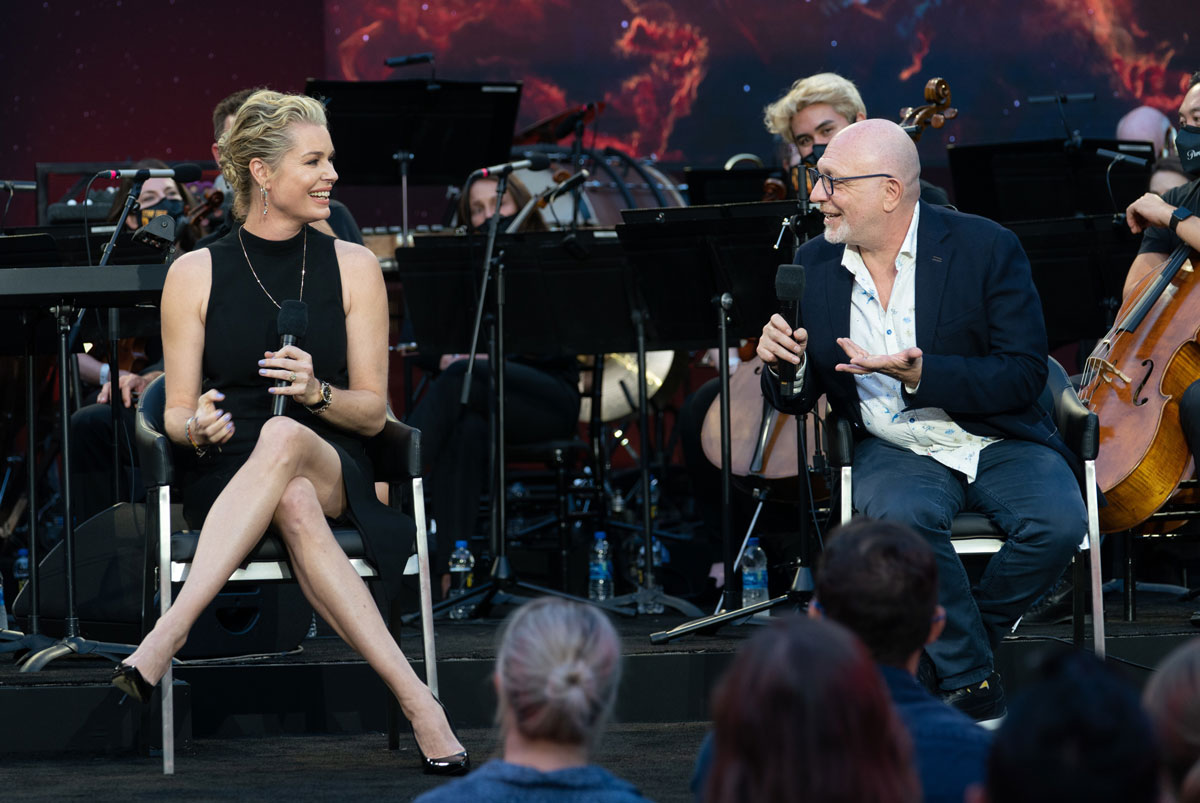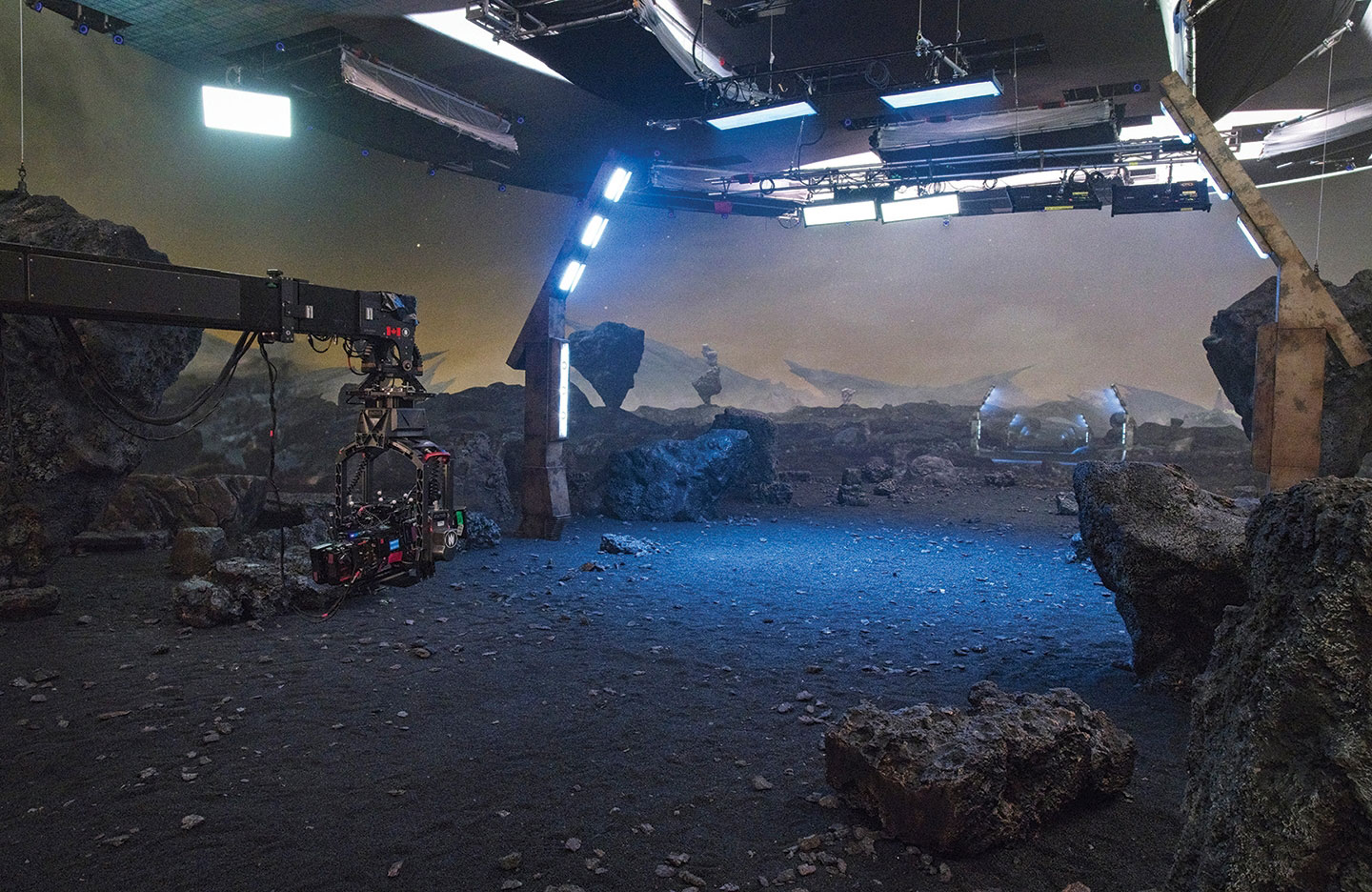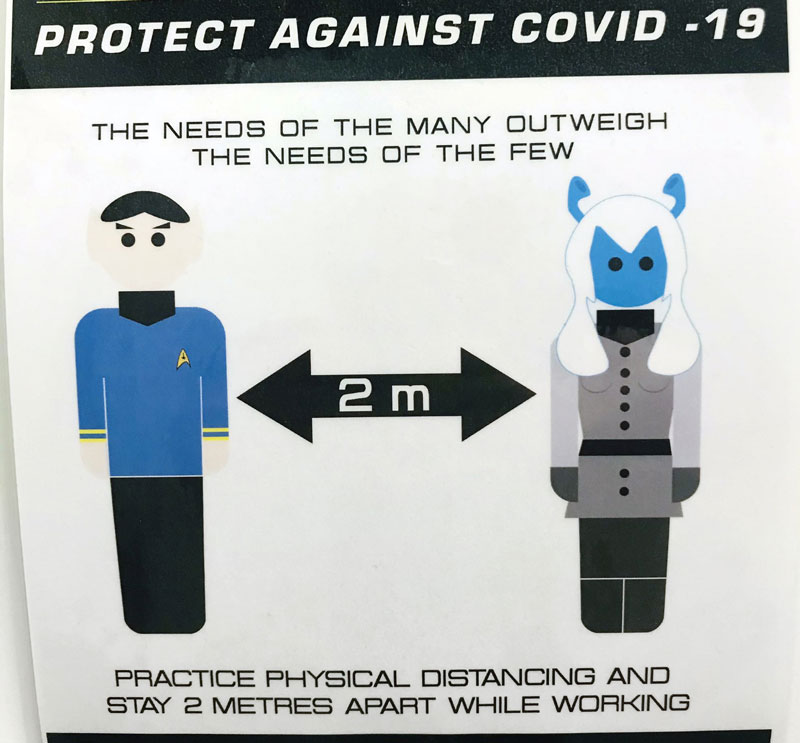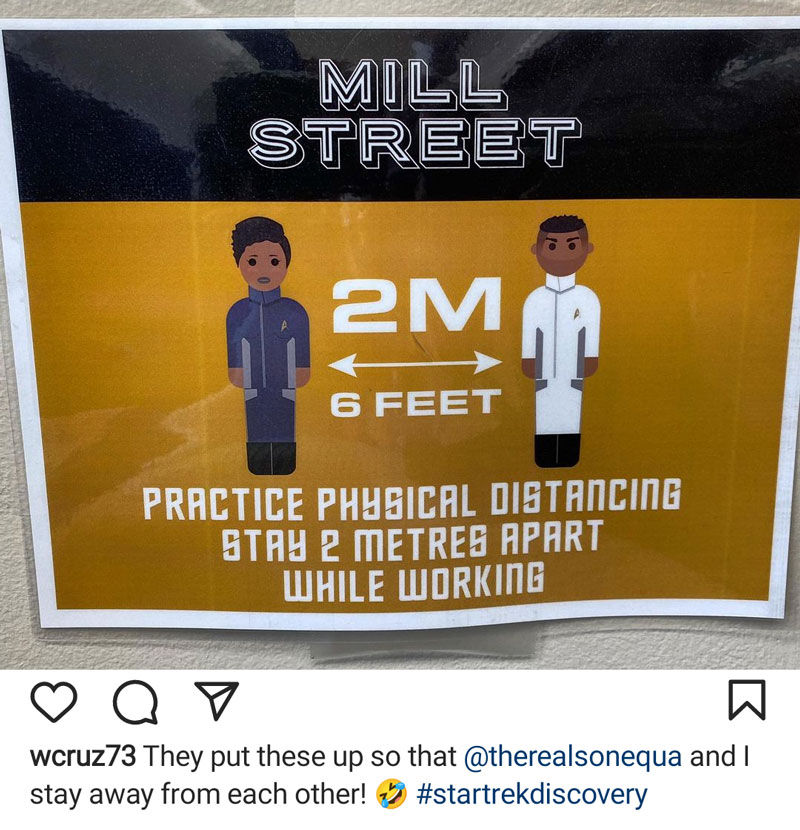Like all film and television production that’s been happening over the last ten months of the COVID-19 pandemic, all three live-action Star Trek faced significant challenges during the course of filming — from maintaining strict on-set health and safety protocols, limiting outside visits to the stages, and seriously restricting location shoots.
Back in October, franchise boss Alex Kurtzman spoke at length about the added weight of pandemic planning on television production, and cast members from Discovery have spoken about their their Season 4 filming experience at a few points during the last year.
Wilson Cruz (Hugh Culber, Discovery) talked during Star Trek Day about the anxiety he felt ahead of returning to set, along with the stress of staying in relative isolation while shooting:
While Toronto-based Strange New Worlds production narrowly escaped a major shutdown back this Spring, their peers at Star Trek: Discovery — which also films in that city — had to close down production for two weeks in April after a primary participant was exposed to the COVID-19 virus.
Last week’s Star Trek Day event brought out some of the biggest names in the current era of Trek production to the first major franchise event since January 2020’s Star Trek: Picard premiere — where all attendees were required to show proof of vaccination to get in, and to wear masks (with limited mask exceptions, only for the stars as they walked the red carpet and appeared on stage).
* * *
During the Star Trek Day event, we had the opportunity to talk with Star Trek: Picard and Star Trek: Strange New Worlds writer, director, and co-showrunner Akiva Goldsman, and later with Strange New Worlds stars Ethan Peck (Spock) and Rebecca Romijn (Number One, a.k.a. Una Chin-Riley), who each told us about their experience bringing these shows to life during the COVID-19 age.

TREKCORE: Speaking strictly on a production level, were the pandemic shutdowns last summer helpful at all — in terms of providing more time to work on scripts, that sort of thing?
AKIVA GOLDSMAN (co-showrunner, Picard and Strange New Worlds): On Picard, I don’t think the extra time really helped us, because we kept having to shift our paradigm of storytelling to compensate for the shifting paradigm of shooting challenges — at least somewhat. It’s not like we threw everything into the trash and started over, but there was enough of that to really make us wish we could just get started with filming.
There wasn’t as much extra time as one may have hoped when it came to Strange New Worlds — but we have this AR wall now in Toronto, and that’s got a learning curve. So more time with that was really helpful.
ETHAN PECK (Spock): The AR wall stage, you and I were on it together the first day, right?
REBECCA ROMIJN (Number One): Yes! It’s really interesting. It’s a huge room with TVs screens on the walls and the ceiling, so it’s hot, and it’s new so it’s a little glitchy — they would stop things every so often and say, “there’s a gremlin on the wall!,” which means it was time for a total reboot of the system. That would take about 20 minutes to reset.
There was some technical stuff to get used to, but it’s better than working on a greenscreen set where you have to try and imagine what you’re supposed to be looking at – because with the AR wall it’s almost like you’re working with practical effects, like you’re in that world, and you can see what it looks like.
PECK: You share that imagery with your acting mates, too, and that’s really a huge help.
ROMIJN: It gives everything an extra energy, since you don’t have to guess what the world looks like.

TREKCORE: Were you able to get out on location at all during the season?
ROMIJN: We were able to go on location a little….
PECK: I got out a couple times, but I don’t know about the other actors.
TREKCORE: For Picard, why time travel back to present day Los Angeles? Trek has a long history of bringing characters back to ‘now,’ but was that a COVID decision — to get out of the stages and into ‘fresh air?’
AKIVA GOLDSMAN: Terry Matalas, my co-showrunner on Season 2, the time travel was his idea.
We were just building the very beginnings of the season; it was me and Michael Chabon, and Terry, and he was like, “Let’s do The Voyage Home — how do we do that kind of thing that we all love with Picard?”
But no, it wasn’t a decision that came from the pandemic — it was, actually, a pre-COVID decision that was actually made very challenging because of the pandemic. Even though we were filming outside, you are still so limited in terms of background extras and what you can do.
Anybody shooting during this period is operating on bubble gum, shoestrings, smoke and mirrors, and the hope that you just get through the day. We took it day by day, because plans didn’t typically… like, if one person was sick, it had the potential to take an entire department down. Safety regulations would change.
It was great to have a job, but it was a challenge.
Also Picard says #WearAMask!😷 #StarTrekPicard #SetPic #BTS pic.twitter.com/BuT1cFlk7l
— Trek Central (@TheTrekCentral) May 1, 2021
TREKCORE: And now you’re going right into Season 3!
GOLDSMAN: Yes, the show’s shooting back-to-back, God bless Patrick Stewart. We just finished shooting Season 2 about three days ago, and I haven’t seen final cuts on the last two episodes yet.
TREKCORE: That two-season run was certainly a rumored plan before the pandemic; was it a challenge to stick to that decision?
GOLDSMAN: We just wanted to power through. Shooting has been really challenging in COVID, especially Picard — but what was most appealing about shooting Picard in Los Angeles also became the most challenging, because we couldn’t really use the city the way we really wanted.
It was definitely different – I think you’ll be pleased with what you see – but it wasn’t what we expected.
TREKCORE: How would you compare the Picard shoot in California to Strange New Worlds up in Toronto, now that each show has a season of ‘pandemic production’ wrapped?
GOLDSMAN: I think the only difference between the two shows, when it comes to COVID, is that Toronto was in a full lockdown for almost the entire duration of Season 1.
So, I directed the first episode of Strange New Worlds, right? I had to go sit in a room for 14 days [after traveling to Canada.] I mean, 14 days by yourself? I don’t even like me that much on a good day! But that was the truth of how we all got through it.
And even if people would see each other [outside of filming], the world was very small – no one could go out to a restaurant, no shopping, nothing was open. It was very different in Los Angeles, where everything had reopened – there was a whole world going on. But even there, you’re still always on COVID testing protocols, and those are always lagging.
So it’s a little more in flux, doing things in a big city like LA that lifted some of those regulations, where it was probably much lonelier for everyone in Toronto.

REBECCA ROMIJN: It was crazy. We started filming, really, at the height of the pandemic in Toronto. The infection numbers were terrible and every city was on complete lockdown, everything was shut.
ETHAN PECK: It was super weird.
ROMIJN: Our cast wasn’t allowed to hang out with each other outside of work at all, and even when we were on set, we could work together when we were filming — but as soon as the scene was done we had to go back to our chairs, spread out 10 feet apart, and we couldn’t go talk to each other.
PECK: It was pretty dark. The only good parts were interacting on camera, because we couldn’t do much of it otherwise.
ROMIJN: It was the only time we ever got to hang out, coming to work together. We couldn’t even see each other on the weekends. Like, there’s always going to be some comradery – because everyone’s so talented – but at the beginning, I was like, “We don’t know each other!”
I mean, casts usually spend a lot of time bonding outside of work.
TREKCORE: It’s not like other shows that had been operating for a while, then got interrupted by the shutdowns.
ROMIJN: Exactly. I mean, Anson [Mount], Ethan and I had already worked together on Discovery and the Short Treks, you know, so we had spent more time together. But Strange New Worlds has a big cast, and it took a long time for us to start to get to know each other.
PECK: I almost never saw Babs [Olusanmokun, who plays M’Benga]. I saw him on set for maybe, like, three days? It’s crazy. He’s like this mysterious person I’m very excited to get to know.
I’m really interested to see how this season turns out, compared to others; hopefully we’ll get more seasons.

TREKCORE: Aside from the self-quarantine, Akiva, what was it like directing the Strange New Worlds pilot — being the one to set the tone of that show in that way?
AKIVA GOLDSMAN: Oh, it was great fun, I loved it. I mean, you know, I wrote the premiere too, so for me that’s really the part where I was setting the tone.
I’m a director, but really, I’m a writer first — so I put things in the hands of those people who know better than me, of which there are many. I’m smart enough to say, “Gee, I wish the scene felt like this…,” but when it comes to the actual visual presentation and grammar of the show, I have such good partners.
Glen Keenan is the show’s director of photography, and he really set the look of things. We had a great team – technicians and artists who build the look for the show, which I’m really proud of – and not just because I started the pilot, but because it harkens back to the Original Series and at the same time, is modern.
It was a really fun thing being part of the team that developed that.
TREKCORE: Rebecca, what are you most excited for people to learn about Number One?
REBECCA ROMJIN: Well, there’s a big reveal that I was very excited about — I can’t tell you what it is, but Akiva told me about it before we started shooting, and I think it really informs a lot of who Number One is, her character, and it really affects everything for the season.
TREKCORE: Ethan, you started out playing Spock as a guest star on Discovery, of course — now that you’ve moved into a lead role on your own series, has that changed how you approach the character?
ETHAN PECK: It feels very different for me, at least, the process of preparing [to play Spock] is very different. It feels like a much bigger responsibility, because there’s so much more nuance I need to bring – because the literal time spent with this character has grown by tenfold, compared to the time I was on Discovery.
TREKCORE: Plus, you don’t have the beard this time around!
PECK: Yeah, absolutely. Without the beard the character does feel kind of raw and vulnerable; there’s no barrier between my interpretation of Spock and the audience.
I think having the beard gave me a kind of ‘soft landing’ into the part… so I hope it works out!
These interviews have been condensed and edited for clarity.
![]()
Star Trek: Discovery returns for its fourth season on November 18 on Paramount+ in the United States, CTV Sci Fi Channel in Canada, and on November 19 on Netflix in all other international regions.
Star Trek: Picard returns for its second season in February 2022 on Paramount+ in the United States, CTV Sci Fi Channel in Canada, and on Amazon’s Prime Video service in other international regions.
Star Trek: Strange New Worlds is slated to debut sometime in 2022 on Paramount+ in the United States and CTV Sci Fi Channel in Canada; additional international distribution has not yet been announced.
